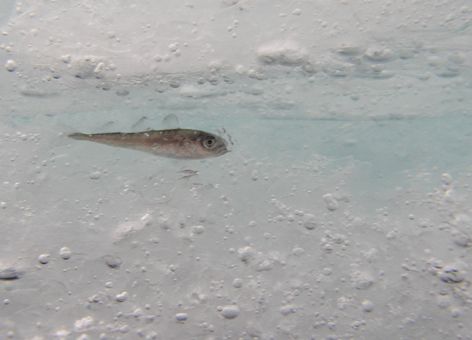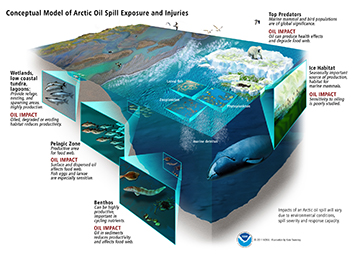How Would Chemical Dispersants Work on an Arctic Oil Spill?

JULY 9, 2012 — If there were a huge oil spill in the Arctic, would chemical dispersants work under the frigid conditions there? And once dispersants break down oil into smaller droplets, how toxic are the oil and chemicals to key species in the short Arctic food web? Would the dispersed oil and dispersant actually biodegrade in cold Arctic waters? With Shell currently on track to drill several exploratory wells in the Chukchi and Beaufort Seas this summer, these are very timely questions—and finally, we are beginning to find some answers.
For the last three years, a special oil industry research group (called a "joint industry program") has been trying to resolve these questions before any major oil exploration, development, and production happens off the northern Alaskan Arctic coastline. Lead scientists Dr. Jack Word of Newfields Environmental (Port Gamble, Wash.) and Dr. Robert Perkins of University of Alaska, Fairbanks, coordinated this research program to determine the viability of using dispersants on Arctic Ocean oil spills.

Aiming for as realistic Arctic conditions as possible, they captured arctic zooplankton (krill and Calanus copepods, which are tiny marine crustaceans) as well as larval and juvenile fish (arctic cod and sculpin) from the coastal waters of the Beaufort Sea. These organisms are key players in the Arctic food web and culturing them in order to conduct toxicity tests hopefully would reveal how negative impacts from oil and dispersants could cascade through the ecosystem. The researchers also conducted toxicity and biodegradation tests in actual waters collected from the Beaufort Sea. Five oil companies were pooling their talents and financial resources to conduct these tests and gather information: Shell, ConocoPhillips, Statoil, ExxonMobil, and BP.
NOAA's Scientific Support Coordinator for Alaska, John Whitney, was fortunate enough to serve on a unique, yet very important, part of the group: the Technical Advisory Committee, which is composed of non-industry technical and non-technical stakeholders. We met once a month to discuss the results and advise them on ongoing scientific tests. Drs. Word and Perkins and their colleagues recently presented the results of this research at a workshop in Anchorage, Alaska. The workshop began with Tim Nedwed of ExxonMobil making a strong case for immediate and robust access to all the major oil spill response options—mechanical methods, in situ burning, and dispersants—in order to deal with a large oil release in the Arctic or any other location.
Mechanical methods (e.g., skimmers) and in situ burning typically encounter spilled oil at low rates, historically removing only 5% to 15% of the oil on the water's surface. This makes chemical dispersants a very attractive option when approaching a big spill using a large aircraft (such as a C-130) to deliver dispersants. After all, Dr. Nedwed pointed out, the ultimate goal of dispersants is to deliver a significant boost to the rate of oil biodegradation that happens naturally after most oil spills. Here are some of the major findings from their research:
- Arctic marine species show equal or less sensitivity to petroleum after exposure than temperate (warmer water) species.
- The Arctic test organisms did not show significant signs of toxicity when exposed to recommended application rates of the dispersant Corexit 9500 by itself, which also tends to biodegrade on the order of several weeks to a few months.
- Petroleum does biodegrade with the help of indigenous microbes in the Arctic’s open waters under both summer and winter conditions.
- Chemical dispersants more fully degraded certain components of oil than petroleum that was physically dispersed (for example, from wind or waves breaking up an oil slick).
- Under various scenarios for large and small oil spills treated with Corexit 9500, the effects on populations of arctic cod, a keystone species in the Arctic, appeared to be minor to insignificant.
This workshop garnered attention from the oil industry, government regulatory and natural resource agencies, academia, Alaska North Slope residents, private consultants, and non-governmental organizations. It concluded with a brief discussion of Net Environmental Benefit Analysis, a scientific process of weighing the costs against the benefits to the environment, with emphasis on the importance of making this process both science-based and, at the same time, compatible with listening to the subsistence Alaska Native population, a significant and valuable voice in the Arctic.
 An official website of the United States government.
An official website of the United States government. 